Chapter 20. Reval [October 4, 1347]
Cultural Explanations
 |
Chapter 20. Reval [October 4, 1347] Cultural Explanations |
|
|
In this chapter Bávlos delivers the statue but finds that Reval has changed ownership. | ||
| Reval |
In this chapter, Bávlos arrives at the bustling Hanseatic city of Reval, today known as Tallinn, the capital of Estonia. In 1346 Reval was turned over by the Danes to the Teutonic Knights, as explained by the priest. Stig Andersen was indeed the man who ran Reval for the Danish crown before the city (along with the rest of the Danish possessions in today's northern Estonia) were ceded to the Knights. Reval, as a Hanseatic city, was largely German speaking, and the take-over of the Knights must have eased some of the linguistic and cultural tensions between German-speaking merchant townsmen and their Danish rulers.
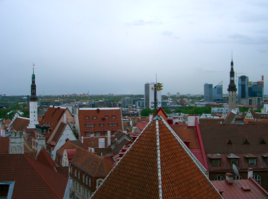 |
 |
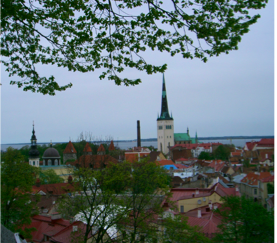 |
Up to this point, Bávlos has met only members of the Dominican order. The Dominicans were focused on preaching and ministry to the peasantry and were of great importance in Finland, Sweden and Gotland. Now, however, Bávlos comes into contact with a very different order of religious: the Teutonic Knights. Founded in the twelfth century to protect pilgrims to the Holy Land, the Knights were an order of monk-soldiers who lived in castles both in the Middle East and in the eastern Baltic. Their presence in the latter region dated from the thirteenth century, when they convinced the pope that a crusade against the pagans of the eastern Baltic should be undertaken alongside the ongoing crusades to the Holy Land. The Knights were eventually active in what is today Estonia, Latvia, Kaliningrad, Lithuania, and Poland. Their practice was to subdue a region militarily, fortify it by building castles, and then administer it as a fiefdom. They were not against fighting against the Orthodox or even against other Western Christians for control, and by the fifteenth century, many critics of the order believed that the Knights harmed missionary efforts in the region more than they helped them. Military force seldom works as a means of promoting conversion to a new religion, although it has been resorted to many times in the past. In any case, acquiring the north of Estonia from the Danes in 1346 allowed for the Knights to begin a military buildup in anticipation of further wars against the Orthodox Novgorodians. It was probably in part this build-up that led King Magnus of Sweden to plan his own crusade against the Novgorodians as discussed in earlier chapters. Perhaps he recognized that if the Knights could overtake the Orthodox of the eastern Baltic, they might well work their way up into Finland as well.
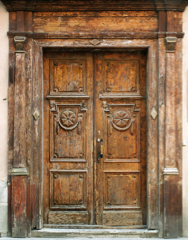 |
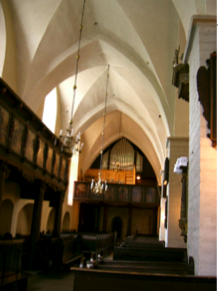 |
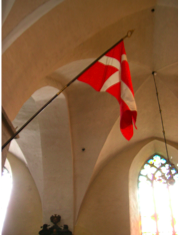 |
The church where Bávlos brings his statue is located in the lower city region of Tallinn. The church, now known by its Estonian name Püha Vaimu ("Holy Spirit") is steeped in history. In the rear area of the church, you can find a Danish flag: a reference to the famous legend of the birth of the Dannebrog in a battle that reportedly took place between Christian Danes and pagan Estonians in the year 1219. The priest retells the legend much as it is recounted in Danish legends today.
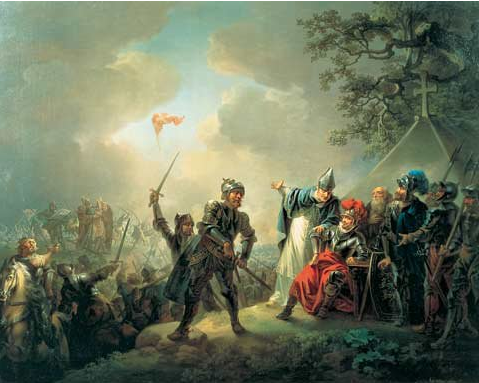 |
Danish romantic painting of the divine appearance of the Dannebrog. Lorentsen, 1809 |
Scholars have argued about the probable age of this legend of the flag. Some believe it dates to the medieval period itself; others point out that the earliest references we have to the divine origin of this flag date from later eras, i.e., the sixteenth century. The controversy is well discussed in an article on Wikipedia which you can read HERE.If the legend really dates only from this later period, of course, Bávlos could not have heard about it at the church in Reval. On the other hand, the brutality of the Teutonic Knights, although infamous, cannot be consigned merely to legendry.